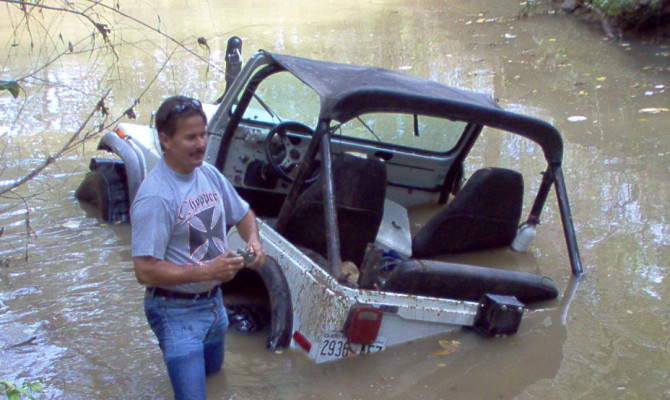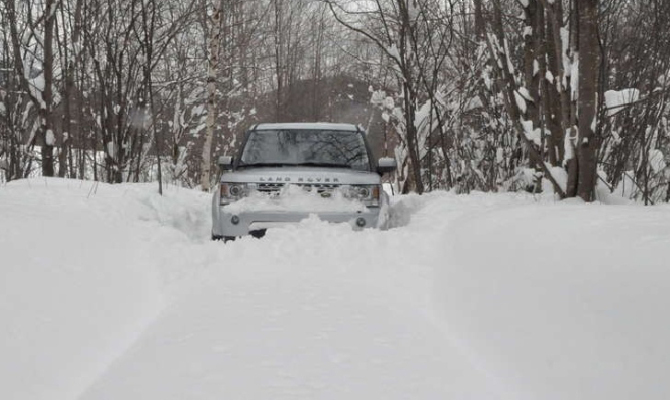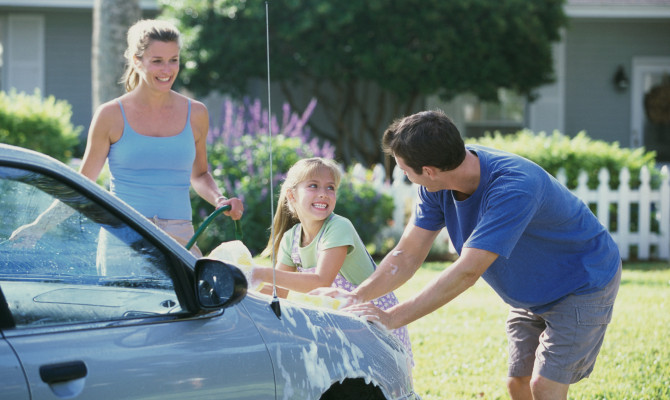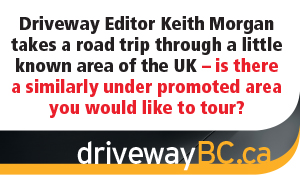Every day there are situations where you need to yield to another vehicle, motorcyclist, pedestrian or cyclist. Failing to yield may seem harmless but it’s a high-risk driving behaviour that leads to crashes.
When turning left, don’t let pedestrians be your blind spot.
“Think about that water entering areas of your truck, believe me, you would prefer it did not do so!”
Spring-like weather means the back woods trails are already beckoning us out here in the West.
While my Driveway colleagues seem to have spent the last month ploughing through snow and ice back East, I’m raring to get out there in our beautiful back yard.
However, there are a few things to think about before you head out into the back roads of British Columbia this spring, to find yourself driving through those swollen creeks and rivers. (more…)
“Actions by cars and trucks will alert you more quickly to problems and give you a split second extra time to react safely.”
The rain and windstorms have started and it won’t be long before the temperatures start to dip. Northern B.C. and the Interior have already experienced the cold.
At the coast, it seems every year the first snowfall creates chaos and adjusting to the conditions is a big challenge for many people. That said; driving in the winter season generally presents more problems than driving in other seasons wherever you call home. The vehicle and the driver must be prepared as well as possible to cope with these kinds of driving conditions.
In winter driving, braking and stopping the vehicle, of course, cause the most difficult moments. The tires play a critical role in stopping the vehicle, and they need even more care and attention than in the other seasons.
Most SUVs have a passenger car tire classification with M+S stamped on the sidewall, for Mud and Snow and are considered all-season tires. If it is not, your vehicle must be fitted with tires suitable for any type of climate, even the most severe ones.
In winter the pressure of the tire must also be controlled more frequently. This is because a reduction of the outside temperature causes a contraction of the air inside the tire, accelerating the normal and gradual pressure loss process by a value around 1-2 PSI for each 5° C decrease in temperature.
Contrary to popular opinion, a lower inflation pressure than normal does not improve tire traction on snow. It makes them much more liable to damage. Always remember that in any season and with any temperature, insufficient pressure is always the main cause of tire damage. Here is some advice to always bear in mind it is during winter driving conditions: Use brakes carefully. Brake early. Brake correctly. It takes more time and distance to stop in icy conditions. Watch for slippery bridge decks, even when the rest of the pavement is in good condition. Bridge decks will ice up sooner than the pavement. Do not use the cruise control in winter conditions. Even roads that appear clear can have sudden slippery spots and the short touch of your brakes to deactivate the cruise control feature can cause you to lose control of your vehicle. Don’t get overconfident in your 4×4 vehicle. Remember that your four-wheel drive vehicle may help you get going quicker than other vehicles but it won’t help you stop any faster.
Many 4×4 vehicles are heavier than passenger vehicles and actually may take longer to stop. Don’t get overconfident in your 4×4 vehicle’s traction. Your 4×4 can lose traction as quickly as a two-wheel drive vehicle.
If your vehicle is equipped with anti-lock brakes, do not pump them in attempting to stop. The right way is to step on the brake pedal and steer against the slide. Look further ahead in traffic than you normally do. Actions by cars and trucks will alert you more quickly to problems and give you a split second extra time to react safely.
As schools begin their summer break, there will be more children around roads. Road safety is not always top of mind for kids so make sure you pay extra attention, especially around playgrounds where speed limits remain in effect year-round.
 I watched a left-turning driver hit the horn (just once) to urge the driver ahead to move into the intersection. The woman just shook her head and stayed put but, when the light turned red, she took off!
I watched a left-turning driver hit the horn (just once) to urge the driver ahead to move into the intersection. The woman just shook her head and stayed put but, when the light turned red, she took off!
What logic was she using to figure – wrongly – that it was unlawful to enter the intersection and yet legal to enter and turn on the red? (more…)
As driving conditions improve, many teens hit the road for the first time in the month of June. The type of car your teen learns to drive on can make a big difference – make it a manageable size, with good visibility and an automatic transmission.
This week is Bike to Work Week in B.C. and more and more people are taking up cycling as a commuting option. It’s important for cyclists to pay attention to vehicles turning at intersections. As a driver, before you or one of your passengers open a vehicle door, always check for oncoming cyclists.
 Spring has sprung and the weekend drivers are out in force on the Sea to Sky Highway. Frustrating to find yourself as one of a dozen following a driver who won’t even match the posted speed limit. And then when you get to a passing lane he speeds up rather than move over!
Spring has sprung and the weekend drivers are out in force on the Sea to Sky Highway. Frustrating to find yourself as one of a dozen following a driver who won’t even match the posted speed limit. And then when you get to a passing lane he speeds up rather than move over!
What drives-u-crazy? (more…)
Unnecessary weight increases fuel consumption and some of that extra weight could be in the form of mud and dirt on your vehicle’s undercarriage…
If a road trip is part of your vacation plans this summer, it’s time to get the horseless chariot prepared.
That means cleaning it inside and out and performing some important maintenance to ensure you get the best fuel economy.
In most parts of B.C., the swap from winter tires to all-season or summer tires is already well under way (studded winter tire removal is mandatory by April 30). Winter tires are made with a softer and stickier rubber compound that wears faster and increases fuel consumption at higher temperatures. They also tend to be noisier and you’ll hear them even more, now that you can finally roll down the windows.
You may also be dragging around too much junk in the trunk, such as that snow shovel you always pack during in the winter months. Unnecessary weight increases fuel consumption and some of that extra weight could be in the form of mud and dirt on your vehicle’s undercarriage.
(Road salt is probably also trapped in that muddy mess, which is a corrosion accelerant that your vehicle’s body doesn’t need.)
While you’re poking around in the trunk, take a look under the floor cover. Water leaking into the vehicle tends to accumulate in the lowest spots, or maybe that’s why it’s called a spare-wheel well. If the spare is a conventional tire, check its inflation pressure and, while you’re at it, make sure that the emergency jack and tool kit are also in good working order.
An easy check and repair item is lighting. You may need some help confirming that the brake and backup lights are functioning at the rear. Otherwise, it’s a simple walk-around check that should include the turn signals and headlights (both low and high beams) and don’t forget the license plate and those little side marker lights. If you’ve got a vehicle with a headlight (clear plastic) cover that’s showing its age, there are some good products on the market now that help restore clarity.
Wiper blades are another easy check and replace item. A build-up of grease or grim on the windshield will also reduce the effectiveness of the wipers. Clean the rubber wiper blade with a soft cloth soaked in the glass cleaner. In B.C., those windshield wipers typically work harder than anywhere else in Canada and life expectancy can be less than a year.
If they’re still streaking, chattering or generally not doing the job – replace them.
Getting back to tires, a loaded vehicle driven at highway speeds for prolonged periods in hot weather conditions can be a punishing test for tires and the dreaded blow-out is a real concern. Even a tire that looks okay and has plenty of tread remaining may not be in great shape. The “best before” date on most passenger tires is eight years old and you should be able to find a date of manufacture stamped somewhere on sidewall of the tire.
A tire also performs best, lasts longer and provides best fuel economy when its internal pressure is set at a level recommended by the vehicle manufacturer, and checked on a regular basis. The tire decal, with optimal front and rear recommended tire pressures, is usually on the driver’s door or door jam. If not, the owner’s manual should give you the information and/or tell you where the tire decal is located. A single under-inflated tire (by about 6 psi /40 kPa) can cause a 3 per cent increase in fuel consumption.
Using a grade of fuel with a lower octane rating than recommended by the vehicle manufacturer may cause the engine to ping or knock on hard acceleration or when climbing hills, which is not good for the engine!
On the other hand, using a higher-octane fuel than your vehicle’s engine needs is generally a waste of money. That said, the pricier fuel may also contain some additional cleaner additives, which is good.
Have a great summer and a safe driving vacation.
 Reader Yvonne Logan thinks there should be a universal hand signal that would alert a following car’s driver that they have left on their high beams.
Reader Yvonne Logan thinks there should be a universal hand signal that would alert a following car’s driver that they have left on their high beams.
“I’ve tried sticking my hand out the window and waving and even hitting my brake lights three times as some sort of signal,” Logan writes. (more…)
Recent Comments
- { Enjoyed your Forest of Bowland in the BMW X5M, particularly the photo of the BMW in front of the main part of Stonyhurst College where... }
- { Bantam designed the Jeep, not Willy's or Ford. The American military gave the original Bantam prototype to Willys and Ford to copy. There is plenty... }
- { All Escalades come with a 6.2-lilter V8 engine that produces 420 horsepower. A six-speed automatic is the only transmission offered and drives the rear wheels.... }
- { Alexandra is an excellent journalist. }
Popular Posts
- Journey to a ‘Sparkling’ Luxury Okanagan Resort “Four lucky readers will put a Dodge Journey’s weekend-...
- The Need For Speed: Hike Those Highway Limits More than half of those polled believe the province sho...
- Drives-U-Crazy… Erratic drivers. An early morning drive from Kelowna to Vancouver is nor...
- Readers Respond: The Pros and Cons of Increasing B.C. Speed Limits Increasing the speed limits will only increase risk to...
- Honda CR-V Review: The Compact Crossover To Get Things Done The CRV is a very stylish and aerodynamic crossover veh...









